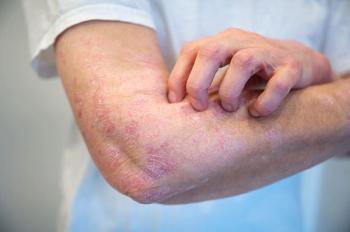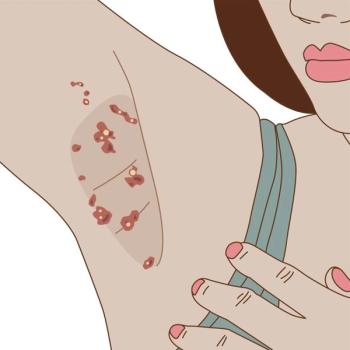
Sexually Transmitted Diseases: Recognizing Telltale Skin Lesions Disseminated Gonococcal Infection
Telltale skin lesions of syphilis, gonorrhea, human papillomavirus infection, and Haemophilus ducreyi infection.
A 17-year-old girl, who reported having unprotected sexual intercourse, complained of lower abdominal pain; vaginal trichomoniasis was diagnosed. Metronidazole was given for 8 days, and the symptoms resolved. One week later, joint pain and skin lesions developed. Three weeks after the original diagnosis, the patient was admitted to the hospital with night sweats, fever, and a rash.
About 20 nontender pustules were noted on the patient's hands, wrists, buttocks, and feet (A and B). Newly erupted lesions were seen on the soles; the patient had applied skin cream to an early pustule on the left sole. Joint tenderness was present in the left foot and knee and the right ankle. The white blood cell (WBC) count was 10,560/µL.
A clinical diagnosis of disseminated gonococcemia, or gonococcal arthritis-dermatitis syndrome, was made. Subsequently, blood and cervical cultures grew Neisseria gonorrhoeae on Thayer-Martin and chocolate agar media (C). Intravenous ceftriaxone, 1 g qd, and oral doxycycline, 100 mg q12h, were given; symptoms resolved within 48 hours.
Disseminated gonorrhea occurs in 0.5% to 3% of patients with gonorrhea. Untreated, asymptomatic primary disease is more common in women who are predisposed to gonococcal dissemination by menstruation and pregnancy.1,2
The pathogenesis of the gonococcal arthritis-dermatitis syndrome is unclear; however, bacteremia and immune complex formation have been demonstrated.3 Interestingly, the gonococci that cause disseminated infection are distinct from those that cause urethritis in that the former are resistant to complement- mediated bactericidal activity.4
The gonococcal arthritis-dermatitis syndrome typically presents as a 3-week primary infection with joint pain, fever, and rash.2 Disseminated gonococcemia most commonly features a pauciarticular arthritis of the wrists, fingers, elbows, knees, and ankles. HIV-infected patients often have involvement of typically unaffected joints, such as the sternoclavicular and hip joints.1
About 50% of patients with disseminated infection have dermatitis. Typically, few (between 2 and 20) lesions erupt, mostly on the distal extremities. Erythematous pinpoint macules may progress to vesiculopustules, tender or necrotic papules, or hemorrhagic bullae. These lesions are thought to be microabscesses of the skin that are secondary to embolization of bacteria.5 The WBC count is usually mini-mally elevated, as in this patient.5
Generally, the diagnosis is made clinically; however, it is advisable to confirm the presence of the organism by culture isolation.2,3 Early in the disease course, blood cultures may be positive for gonococci, whereas cultures of skin lesions with chocolate agar and modified Thayer-Martin media are often negative.2,4 A DNA probe assay that is effective on a nonviable specimen can be used as an alternative to culture for diagnosis.6
Intravenous ceftriaxone for 2 or 3 days followed by an oral antibiotic, such as cefixime or ciprofloxacin-- for a total of 1 week of treatment--is recommended. Alternative regimens are available for patients who are allergic to these agents. Symptoms typically resolve within 24 to 48 hours after therapy is initiated. Concomitant administration of doxycycline for Chlamydia infection is routine, since 50% of patients with disseminated gonococcemia are coinfected.2
Pelvic inflammatory disease is the most significant complication of gonococcal infection in women.4,5 Prompt diagnosis and treatment of the infection are essential to prevent infertility, ectopic pregnancy, and chronic pelvic pain. Chronic arthritis, perihepatitis (Fitz-Hugh and Curtis syndrome), endocarditis, and meningitis are rare complications.3
(Case and photographs courtesy of Lisa Travis, MD, Sharon Glick, MD, and Eve Lowenstein, MD.)
References:
REFERENCES:
1. Angulo JM, Espinoza LR. Gonococcal arthritis. Compr Ther. 1999;25:155-162.
2. Brown TJ, Yen-Moore A, Tyring SK. An overview of sexually transmitted diseases: part 1. J Am Acad Dermatol. 1999;41:511-532.
3. Feingold DS, Peacocke M. Gonorrhea. In: Freedberg IM, Eisen AZ, Wolff K, et al, eds. Fitzpatrick's Textbook of Dermatology in General Medicine. 5th ed. New York: McGraw-Hill; 1999:2598-2603.
4.Schoolnik GK, Buchanan TM, Hohnes KK. Gono-cocci causing disseminated gonococcal infection are resistant to the bactericidal action of normal human sera. J Clin Invest. 1976;58:1163-1173.
5. English JC, Monk JS. Gonococcal dermatitis-arthritis syndrome. Am Fam Physician. 1986;34: 77-79.
6. Schwebke JR, Zajackowski ME. Comparison of DNA probe (Gen-Probe) with culture for the detection of Neisseria gonorrhoeae in an urban SID programme. Genitourin Med. 1996;72:108-110.
Newsletter
Enhance your clinical practice with the Patient Care newsletter, offering the latest evidence-based guidelines, diagnostic insights, and treatment strategies for primary care physicians.





















































































































































































































































































